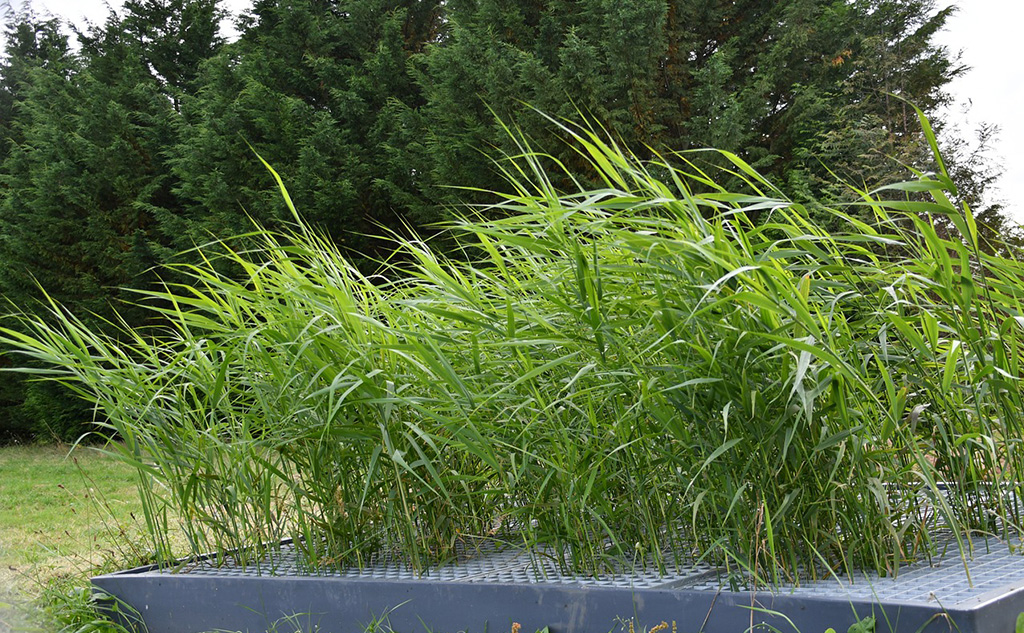In the field of water management, the reed bed filter (RBF) system has been in place for almost thirty years in France. Originally intended only for wastewater treatment, it has since been used for rainwater management and flood prevention. Although it is a solution based on nature (it is directly inspired by the functioning of wetlands), the fact remains that the installations evolve and are subject to ageing.
What is a reed bed filter?
A reed bed filter is based on a simple principle: to circulate the water to be treated through a layer of filtering material in which bacteria (purifying biomass) and plants develop. It therefore improves the quality of the water by filtering and degrading pollutants. Consisting of a basin filled with a mineral substrate planted with reeds, this arrangement is usually in two stages and can either be watertight or allow infiltration depending on the context. It is often coupled with other structures such as a settling tank upstream or a discharge zone downstream.
How does it work?
The RBF contributes to water purification through the combination of a substrate (gravel or sand), the reeds (through their root system) and the micro-organisms that settle on it. There are two types of filters depending on the type of water inlet: the vertical flow filter (often combined with mechanical filtration) and the horizontal flow filter. The degradation of organic pollution is ensured by micro-organisms linked to the rhizomes and roots.
RBFs offer good purification performance(1), do not produce sludge, do not generate odours and are integrated into the landscape. What is more, they have low energy consumption. On the other hand, they require a large surface area and must be subject to annual control and maintenance operations, including “mowing” of the reeds (a cut that provides oxygen) and cleaning of the system.
What ageing of the sector?
Today, there are no less than 4,620 RBF installations in France (i.e. nearly 20% of the country’s wastewater treatment plants). They are the most widespread wastewater treatment technology in rural areas, particularly for small and medium-sized communities with 50 to 4,500 population equivalents.
In 2019, the French Agency for Biodiversity commissioned the national group EPNAC (Evaluation of new sanitation processes for small and medium-sized communities), which specialises in integrated urban water management in small and medium-sized communities, to study the ageing of the RBF system and any malfunctions observed, with a view to optimising the lifespan of the facilities and anticipating renewal and rehabilitation needs(2).
This study first of all clarifies the difference between fouling and clogging. Fouling due to the formation of a deposit on the filter is normal. It results in a progressive reduction in porosity but does not cause the system to malfunction. On the other hand, clogging, which corresponds to a too rapid clogging, is characterised by a reduction in the infiltration capacity, which leads to malfunctions that can lead to overflows but also to non-compliance with discharge standards. According to the authors of the study, “this premature clogging is very problematic because operators have few solutions to solve the problem, other than waiting or carrying out costly early cleaning”. For them, “efforts still need to be made to understand the mechanisms by which this clogging occurs and to develop both preventive strategies (development of indicators, sensors, etc.) and curative solutions that are less costly than cleaning”.
Various types of malfunctions
There are three main types of malfunction. They may be related to the design of the system itself, in particular the drains or the distribution of the effluent. They may be due to the management of the installation (plants used and associated maintenance tasks). Finally, malfunctions can be caused by the nature of the input effluent, mainly in the case of hydraulic overload episodes over long periods.
Some of the lines being considered
In order to deal with the problems related to hydraulic overloads, it would be appropriate to adjust the recommendations in this area and the necessary works, in particular the “by-pass”, parallel circuit devices. Similarly, continuous monitoring of a representative sample of stations could help to quantify these overloads.
At the same time, anticipating the need for renewal and rehabilitation requires a good understanding and quantification of the rate of fouling of the RBFs. This requires further research, in particular on fouling mechanisms and the construction parameters on which they depend. It also implies considering the technologies and procedures that will be needed to carry out these replacement or rehabilitation operations. In other words, the RBF sector is likely to undergo new developments in the near future.
(1) Good purification performance on SS (suspended solids), COD (chemical oxygen demand) and BOD5 (5-day biological oxygen demand).
(2) “Etude du vieillissement des filtres plantés de roseaux”, December 2019, IRSTEA, AFB.




